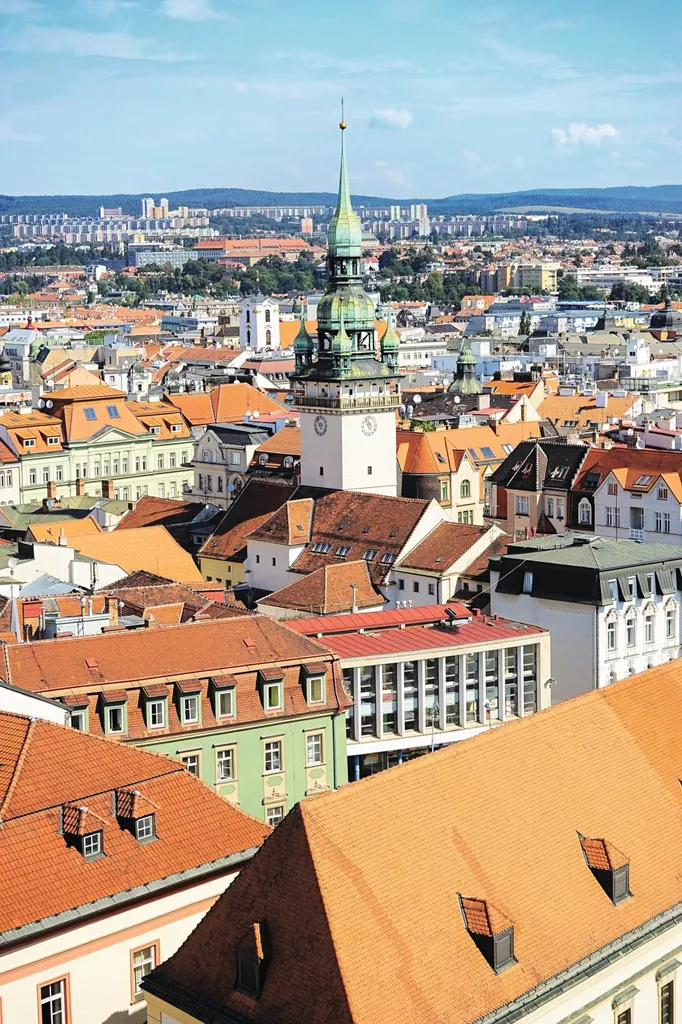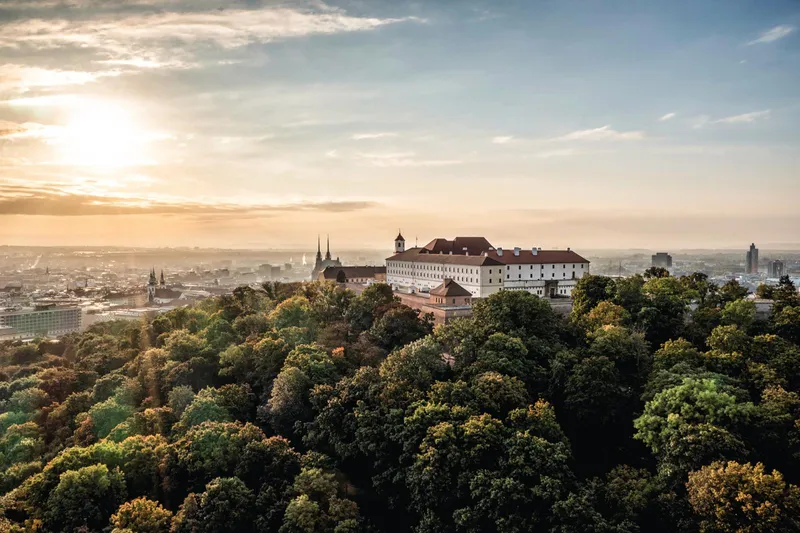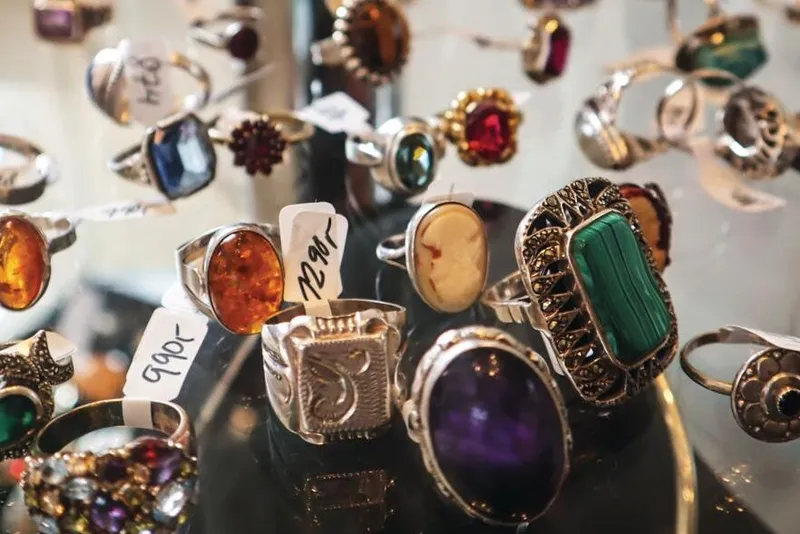Just a few hours by rail from Prague and Vienna, Brno (pronounced ‘burno’) has all the cultural cachet of its neighbours – but without the crowds.
The camp that developed here in the Stone Age flourished when a castle and city walls were built in the 11th century. When the fort was destroyed, the settlement remained, with locals selling produce at the Cabbage Market (Zelný trh), just as they do today.

Back then, traders stored produce beneath the market, in a labyrinth later used as a bomb shelter. Visitors can now explore a wine cellar, alchemist’s workshop and jail inside the kilometre-long passageways.
By the 13th century, Brno was thriving, with residents also trading in Liberty Square. These days, the square hosts lively Easter and Christmas markets, and you can admire its fountain and contemporary
astronomical clock all year round.

Brno’s booming population soon filled St James’s churchyard, which prompted officials to pile skeletons into a neighbouring cavern. When the tomb was unearthed in 2001, the remains of 50,000 humans were found, making it Europe’s second largest ossuary – visitors to the church can now pay to take a candlelit stroll through the cavern.
Day One
Staying with impressive, if somewhat macabre, underground attractions, the crypt of the 17th-century Church of the Holy Cross is well worth a visit. This is the final resting place of 205 people, most of them Capuchin monks, whose bodies dried naturally, without embalming. While there, don’t miss the library’s ceiling fresco by Josef Stern and an altar painting depicting Saint Helena.

St Peter and Paul Cathedral is another historical highlight. Built in 1777 on the site of an older chapel, a spiral staircase coils to the top of its tower, from which you can enjoy a panoramic view of the city. Alternatively, take the Old Town Hall’s 174 stairs to see Brno’s peaches-and-cream architecture with Moravia’s gentle hills beyond.
Having explored underground and gazed across the city’s rooftops, you’ll be ready to discover Brno’s main attractions. Start by exploring Špilberk Castle. Built under Přemysl Otakar II’s rule in the 13th century, it morphed into a jail for political prisoners from the late 1700s and military barracks in 1855.

Today, its permanent exhibitions showcase original floorplans, stories from a 1645 Swedish siege and displays of Brno’s 19th-century textile manufacturing industry, which earned the city the nickname ‘Moravian Manchester’. You can also peruse weapons, garments and porcelain, attend one of the regular cultural events held here, or admire its contemporary art collection. spilberk.cz/en
Art fans will be in their element in the Moravian Gallery. From fine art to applied art, photography to graphic design, this is the Czech Republic’s second largest art museum. It’s actually made up of five buildings but, with limited time, focus on The Museum of Applied Arts or discover Pražák Palace’s modern Czech art.

An eight-metre tall sculpture, Statue of the Knight, marks the entrance to the Governor’s Palace; its European art collection is scheduled to reopen this year. moravska-galerie.cz
Like the towering knight, the Museum of Romani Culture’s three-storey mural depicting accordion players and cellists is another eye-catching piece of public art. The museum’s permanent exhibition offers an enlightening account of Romani life, from the Roma’s origins in ancient India to their 11th-century arrival in Europe, persecution during the Holocaust and post-war achievements in literature and music. rommuz.cz/en
Tugendhat Villa is a 15-minute saunter from the Romani Museum. Completed in 1930 for a textile merchant, the Modernist home is now a UNESCO site. The German architect Mies van der Rohe designed the open-plan house, which has floor-to-ceiling windows; retractable windows and onyx sliding screens instead of walls.

Mies, as he was known, also designed the indoor garden, ebony bookcases and quilted Barcelona chairs made for the 1929 World Fair. The villa’s history is as fascinating as its architecture; after the family
left, the Nazis, then the Soviet Union’s Red Army, occupied it before it was turned into a children’s rehabilitation centre. tugendhat.eu/en
Day Two
After a busy day visiting Brno’s cultural sights, unwind by meandering around the Old Town’s antiques shops. Antikvariát Alfa (antikalfa.cz/en) lies in the shadow of Špilberk Castle. Although it specialises in books – most of which are in Czech – Antikvariát Alfa also sells old maps and atlases, vintage comics and graphics and prints, posters, photographs and postcards. The owner can arrange shipping.

Antik Výběr (antikvyber.cz) is just a few doors down. This compact antiques shop displays silver cutlery, clocks and watches in glass cabinets, as well as interesting paintings and rugs. The owner doesn’t speak English, but he’s friendly and helpful.
If you get a kick out of discovering the unexpected, then seek out Baru (baru.cz), where grandfather clocks line the walls, rare stamps adorn the back room and leather-bound radios, old irons and rotary phones litter the shelves. The floor is scattered with typewriters, while dusty boxes are made for rummaging.

There’s not a speck of dust in Starožitnosti Pražák (starozitnosti-prazak.cz/en), however. The two-storey, air-conditioned boutique welcomes serious buyers with coffee and offers cognac over shipping discussions.
Since it opened in 2002, its owner, Ladislav, has specialised in Art Deco jewellery, particularly 1930s sterling silver, as well as antique homeware sourced from the Austrian-Hungarian Empire. ‘The Czech Republic is at the crossroads of European culture,’ Ladislav explains, pointing to a walnut cabinet amongst his stock.

If you’re ready for a pitstop, take a break at SKØG Urban Hub (sog.cz) where vases of wildflowers and potted plants wrapped in fairy lights soften whitewashed brick walls. This is a place to linger over a coffee and chai cheesecake.
Antique Patrice (antique-patrice.cz) is a couple of streets away. A family business since 1992, it’s housed in a baroque building that once belonged to the Minorite Monastery. It specialises in baroque and Renaissance antiques, and pieces sourced from 18th-century France – look out for lampshades, gold charms and blue-and-white porcelain.

There’s more blue-and-white porcelain at Bazar at 63/12 Kobližná, in amongst toy cars and other bric-a-brac, but you have to dig deep to find treasures here.
Where to eat
For a fine-dining experience, head to Restaurant Passage, where a living wall glows under copper lampshades, and typical dishes include duck croquettes, rabbit loin with parsley purée and trout with cauliflower poached in butter. hotelpassage.eu

Vittorio’s contemporary dining room is in a prime spot, between the castle and St Peter and Paul Cathedral. Dine on Mediterranean dishes on a covered outdoor deck or beneath tall ceilings inside. vittoriorestaurant.cz/en
Where to stay
Built in 1596, the 30-room Hotel Royal Ricc near the castle flaunts stained-glass windows, coffered ceilings, frescoes and Old Masters. The royal suite even plays host to a grand piano. royalricc.cz
Near the Cabbage Market is Barceló Brno Palace, dating back to the 1850s. Its 119 rooms boast tall ceilings and wooden floors, while an incredible five-storey atrium shelters the building’s cream façade. barcelo.com

How to get there
Return flights from London Stansted to Brno take two hours and cost from £200. Take the E76 bus (N89 at night) for a 20-minute shuttle to the station. For more information, visit gotobrno.cz/en

